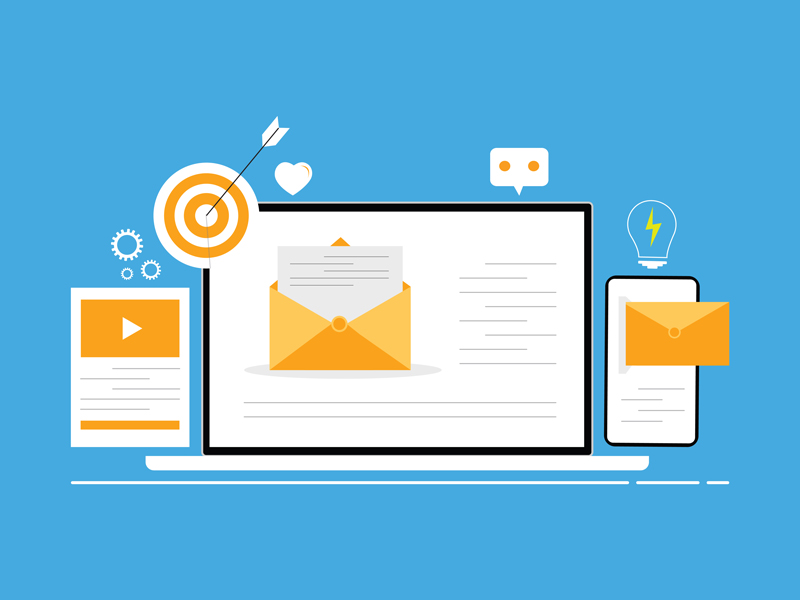FDIC-Insured - Backed by the full faith and credit of the U.S. Government
-
-
-
FNBO
MarketingJun 08 2021
-

Connecting with Customers – How to Nurture Leads with Email Marketing
Email marketing is one of the most inexpensive and effective ways to promote your business. It’s great for reaching out to people who are interested in what you’re selling, while also building relationships over time.
However, email marketing isn’t only beneficial for your business. It delivers real value to your customers by providing updates on products, services or news of interest.
This blog post will show you how to build an email marketing list that can be used to help generate revenue and create more leads for your company.
The Value of Email Marketing
If you’re wondering why email is such a critical tool in your marketing arsenal, a few statistics may help to explain. For one thing, over 90 percent of people in the U.S. over the age of 15 use email to communicate. According to the same report, 99 percent check their email at least daily, and some individuals admit to looking in on their inbox an astounding 20 times per day.
Reviewing statistics like these, it’s easy to see that email marketing is a great way to increase overall engagement and drive traffic back to your website, but the value goes well beyond the benefits of creating an engaged audience. A well-crafted email can drive sales.
In 2020, email marketing conversion rates were over 15 percent and accounted for nearly 20 percent of all sales transactions. In fact, email marketing has a 4,400 percent return on investment overall.
With outcomes like that, even the smallest business may realize effective results. However, it takes some effort to get started.
Tackling the First Step - Growing Your Email Marketing List
The root of email marketing success begins by building a targeted list of customers and potential customers who are interested in your product or service. It’s a process that can take time, so businesses are often tempted to take shortcuts.
One of these involves purchasing a list of potential subscribers from a vendor who specializes in such services. However, these lists can contain outdated information, reducing their value.
By using a purchased list for your email campaigns, you will also be reaching out to cold leads who may not have heard of your business, product or service. This decreases the likelihood that someone will subscribe to hear more from you.
Instead, it’s best to start with those you know. Try asking existing customers during face-to-face interactions if they would like to join your email mailing list to receive periodic updates. You can also put a form on your website, inviting users to subscribe.
Another tactic for drawing new subscribers to your email list is to offer a lead magnet. A lead magnet can be an informative piece of content, such as a thought leadership report, or for consumer audiences, possibly a free sample or coupon.
When individuals sign up to receive your lead magnet, they provide an email address and agree to receive future communications from your company. A lead magnet is particularly effective because it attracts people who are interested in your products or what you have to say. Building an interested audience will increase engagement over time and help you realize better outcomes from your email campaigns.
What Businesses Should Know Before Starting an Email Campaign
Once you’ve built a solid email list, you may be tempted to dive right into sending emails but hold on a minute. Following a few best practice tips will help to ensure more positive outcomes from your efforts.
The first is to familiarize yourself with the CAN-SPAM Act. This regulation passed in 2003 requires email senders to offer readers a simple way to opt out of their subscription, should they no longer wish to receive communications.
Facilitating these unsubscribes from your email list can be time consuming, so it is best accomplished by using a bulk email service. While subscribing to a service is costlier than sending emails from your own business account, it makes it much easier to manage your campaigns.
For one thing, email marketing services can provide you with templates, allowing you to send more professional looking emails. Through a service, you can also schedule email releases in advance and receive valuable metrics that will help to inform future campaigns.
Another best-practice tip involves frequency and timing. It’s important not to send too many emails. If you send multiple messages in a day, your followers may grow weary and unsubscribe.
It’s also smart to think about the day of the week and time of day you send your email. Are your customers online Monday through Friday or more often on the weekends? Again, an email service will provide insights to help you determine this.
Above all, be sure to send timely emails with valuable information. An upcoming sale is always welcome news or highlights on trending industry information.
By growing your email list and sending relevant information, you’ll generate deeper engagement with your customers and even inspire sales. Best of all, email marketing is relatively inexpensive, making it a great tool for businesses of all sizes.
The articles in this blog are for informational purposes only and not intended to provide specific advice or recommendations. When making decisions about your financial situation, consult a financial professional for advice. Articles are not regularly updated, and information may become outdated.